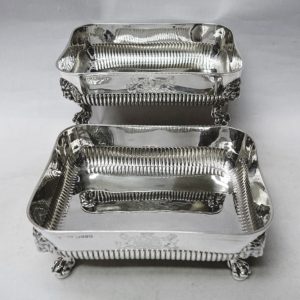Philip Rundell
Philip Rundell, London goldsmith, apprenticed 1760 to William Rodgers of Bath. Arrived in London 1767/69 as shopman to Theed & Pickett, became partner with Pickett 1772, acquired sole ownership 1785/6. Took John Bridge into partnership circa 1788 as Rundell & Bridge, the manufacturer of exquisite goods in precious and semi-precious materials, dealing in silver and silver-gilt, diamond and pearls and all manner of jewellery, gold boxes, watches and objects of vertu. The two were appointed Goldsmiths and Jewellers to the King circa 1797 and the royal warrant continued until 1843. Rundell’s nephew Edmund Walter Rundell became partner circa 1805. Paul Storr worked with them from 1807 until he left to form his own business in 1819.
Although Philip Rundell and John Bridge were both named in the royal warrant of 1797, it was Bridge who acted as Royal Goldsmith until his death in 1834. His nephew John Bridge succeeded him and served in this position until the firm went into dissolution in 1843. From 1805, the firm was known as Rundell, Bridge and Rundell, and from 1834, Rundell, Bridge & Co.
Among their many prestigious commissions the business was responsible for the Crown Jewels used at the coronations of George IV, William IV and Queen Victoria, as well as the wide range of banqueting plate and jewellery now in the Royal Collection.
Philip Rundell
Philip Rundell, London goldsmith, apprenticed 1760 to William Rodgers of Bath. Arrived in London 1767/69 as shopman to Theed & Pickett, became partner with Pickett 1772, acquired sole ownership 1785/6. Took John Bridge into partnership circa 1788 as Rundell & Bridge, the manufacturer of exquisite goods in precious and semi-precious materials, dealing in silver and silver-gilt, diamond and pearls and all manner of jewellery, gold boxes, watches and objects of vertu. The two were appointed Goldsmiths and Jewellers to the King circa 1797 and the royal warrant continued until 1843. Rundell’s nephew Edmund Walter Rundell became partner circa 1805. Paul Storr worked with them from 1807 until he left to form his own business in 1819.
Although Philip Rundell and John Bridge were both named in the royal warrant of 1797, it was Bridge who acted as Royal Goldsmith until his death in 1834. His nephew John Bridge succeeded him and served in this position until the firm went into dissolution in 1843. From 1805, the firm was known as Rundell, Bridge and Rundell, and from 1834, Rundell, Bridge & Co.
Among their many prestigious commissions the business was responsible for the Crown Jewels used at the coronations of George IV, William IV and Queen Victoria, as well as the wide range of banqueting plate and jewellery now in the Royal Collection.
-


1819
Philip Rundell
8842 George III Silver Bowls
Sold
A fine and substantial pair of antique sterling silver serving dishes, large size, and suitable for use as jardinieres. Classical Georgian plain design with rectangular shape and half ribbed body. The applied lions mask mounts and paw feet are of excellent quality. Each has, to the front and back, a large hand engraved armorial supported by a lion and griffin. The motto “Sic Donec” means “So Until”. Total weight 2249 grams, 72.3 troy ounces. Top rim measures 25.5 x 20.5 cms. Height 9 cms. London 1819. Maker Philip Rundell, the prestigious Georgian silversmith and partner of Paul Storr.